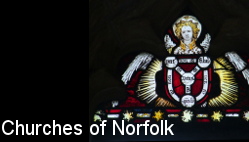
home I index I latest I glossary I introductions I e-mail I about this site
All Saints, Carlton Rode
Follow these journeys as they happen at Last Of England Twitter.
| All
Saints, Carlton Rode Carleton Rode is one of the busy little villages to the east of Attleborough. Its church sits at the eastern edge of the village, a large building with a curiously hunch-backed appearance. The first impression is that a large church has been built against a small tower. In fact, the tower was taken down a stage after a partial collapse into the nave in the 18th Century, and the bare clerestory and steeply pitched roof of the nave are an 1850s rebuilding. Pevsner thought the late 13th Century chancel remarkably lavish, although he did bemoan its c1880 restoration. There are aisles to both sides making a church which is wide as well as being long, although that is not immediately obvious from the outside. Simon Cotton points to a number of late 15th Century bequests which leave money to the bells rather than the tower, which suggests perhaps that the parish were happy with their 14th Century tower and had no plans to elaborate it. When the nave was rebuilt, probably at some time in the late 15th century, this was already an aisled church. The east windows of the two aisles are older than the nave, and the east end of the new arcades falls short of the wide chancel arch, leaving an earlier arch in the south arcade which is little more than a large doorway. Stepping through the south porch into the church, the nave and its aisles open before you, a square space with the serious feeling that comes from the 1870s woodwork which Mortlock credits to Thomas Jekyll, and the clear glass in the windows. The font is a curiosity, for in proportion it is not dissimilar to familiar late medieval East Anglian examples, and yet it is elegantly fluted on bowl and stem with no other imagery. Pevsner thought it was probably 18th Century, in which case it is likely to be a replacement for an earlier font damaged or destroyed by the collapse of the tower. Turning east, the 15th Century rood screen dado survives. If you've not been here for a few years you might be surprised to discover that it is now surmounted by a good late 19th or early 20th Century screen, brought here recently from St John TImberhill in Norwich where it had become surplus to requirements. The dado below it has figures of twelve saints. On the north side they are St Simon, St Jude, St Thomas, St Bartholomew, St John, and St Paul. On the south side they are St Peter, St Andrew, St James, St James the Less, St Philip and St Matthew. If the painting seems a little crisp it is because the panels were restored by the enthusiastic Professor Tristam in the 1930s, almost certainly along the lines of what was there before. Simon Cotton found a 1476 bequest of 3s to the rood loft, which suggests a good date for the screen with its paintings below to have been completed. Earlier than the rood screen are three trefoil panels of glass in the heads of the chancel windows. Indeed, they could be as early as the late 13th Century and date from the rebuilding of the chancel, a most unusual thing to find in East Anglia. Two of them depict symbols of the evangelists, the bull of St Luke labelled Luccas Bos and the eagle of St John labelled Johannes Aquila. The third is King David with his harp. As much as Pevsner bemoaned the 19th Century restoration here, it is worth recalling that many of our church buildings were in a parlous state by the early decades of the century, and and some would have been completely lost to us by now if the Victorians hadn't rolled their sleeves up. A handwritten verse hanging at the back of the church is said to have been an inscription added to the tower when it was repaired after the 1717 collapse, but ironically later lost to the 19th Century restoration, and warns us of the consequences of neglect: This church was built, in it
God to adore, and ought to have been repaired long
before. Simon Knott, April 2023 Follow these journeys as they happen at Last Of England Twitter. |
|
|||||||||||||||||||||||||||||||||||||||||||||||||||||||
home I index I latest I introductions I e-mail I about this site I glossary
links I small
print I www.simonknott.co.uk I www.suffolkchurches.co.uk
ruined churches I desktop backgrounds I round tower churches